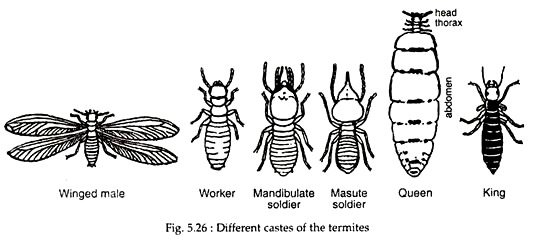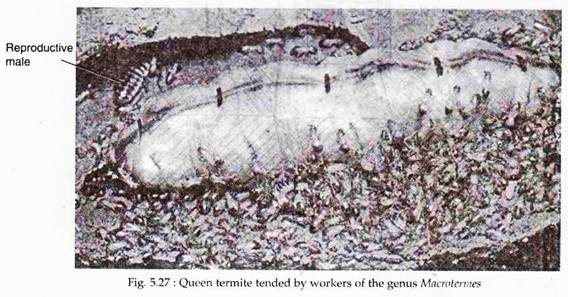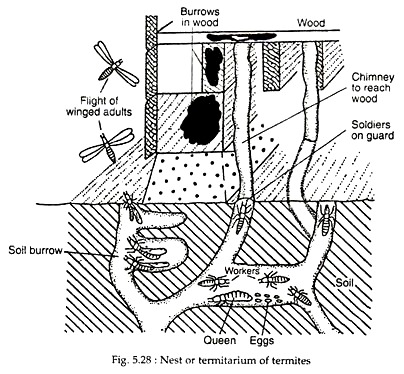In this article we will discuss about:- 1. Eusociality in Termites 2. Nutrition in Termites 3. Formation of Colonies and Development of Caste.
Termites, generally belonging to the family Termitidae, are social and polymorphic insects, living in large and well-organised colonies. Their energy source is wood cellulose, which is digested by flagellate protozoans or other mutualists that live in the intestine of the termites. Termites differ from other social insects in having a large number of castes, of which three are reproductive castes and two are sterile castes.
A. Reproductive or Fertile Castes:
They are of three types:
(a) Macropterous or winged forms:
ADVERTISEMENTS:
These are the normal winged (alate) male and female individuals (Fig. 5.26) forming the true kings and queens. These winged forms are characterised by a dark pigment on the body and possess well-developed eyes, brain, sex organs and two pairs of wings.
The wings are well-developed and longer than the body. The winged kings and queens leave the colony, mate and lose their wings, with only their truncated bases remaining. They then start a new colony.
(b) Brachypterous or short-winged forms:
ADVERTISEMENTS:
They are the short-winged males and females and are sometimes designated as supplementary or substitute or neotenic kings and queens (Fig. 5.26). The wings are vestigeal and pad-like. Body is less pigmented and the compound eyes are small. If the macropterous king or queen dies, its place is taken up by the brachypterous individuals forming substitute king or queen.
(c) Apterous or wingless forms:
These are worker-like substitute kings and queens, often called ergatoid kings and queens (Fig. 5.26). They lack wings and the body is without pigmentation. The compound eyes are vestigeal. The brain and the reproductive organs are less developed than in other reproductive castes. They are rare and found only in primitive termites (Leucotermes).
B. Sterile Castes:
ADVERTISEMENTS:
The two sterile castes of termites are:
(a) Workers:
These are small-sized wingless insects (Fig. 5.26) and include both male and female individuals. Their body has little or no pigmentation. The eyes are usually absent or rarely well-developed. The workers are dimorphic, but rarely trimorphic (Example: Odontotermes), comprising of small, intermediate and large individuals.
The workers are more numerous than any other caste. Except reproduction and defence, the workers perform all other duties of the colony. They care for the eggs and youngs, search for and collect food, feed and tend the queen (Fig. 5.27), cultivate fungus in special chambers (fungus gardens) in certain species, construct the nest or termitarium (excavate tunnels and galleries and construct mounds) (Fig. 5.28), and perform many other duties.
(b) Soldiers:
The soldiers are (Fig. 5.26) highly specialised and are concerned with defence of the colony (Fig. 5.28) against any intruders. They are like the workers (lack wings and reproductive organs), but are somewhat larger and possess stronger mouth parts.
The soldiers are generally of two types:
ADVERTISEMENTS:
(i) Mandibulate soldiers:
They have larger body, strong head and huge mandibles (Fig. 5.26) for driving away intruders.
(ii) Nasute soldiers:
They are relatively shorter with vestigeal mandibles. They are characterised by a median frontal rostrum (Fig. 5.26) bearing the opening of a large frontal gland at its apex. The sticky secretion of the gland is inflicted upon its enemies during warfare and is also used to dissolve hard substances, like concrete, which are in the way of the workers during nest building. They are seen in some higher genera (Eutermes) and may be dimorphic or trimorphic depending on the species.
Nutrition in Termites:
In termites, nutrition largely determines the major sociality. The feeding habit of termites is both complex and remarkable. They feed largely on wood (cellulose) which is digested by a large number of symbiotic intestinal protozoans (Trichonympha etc.). These protozoans enter the alimentary tract of young termites (nymphs) when they feed on fresh faeces of adult. This essentiality lays down the basis of evolution of social life in termites as it results in the overlap between two generations and thus fulfills one of the chief criteria of the sociality in insects.
The higher termites feed upon the fungi and materials other than wood. They build comb-like fungus beds in special chambers of the nest. Among the young individuals, the soldiers and the royal forms are fed by the workers with regurgitated food and saliva. Glandular secretions are exuded by all members from their skin and are licked and groomed by other members. This being necessary for the transmission of the protozoans. Therefore, trophallaxis (the exchange of oral liquid and anal food), is common among termites like that of ants, bees and wasps.
Formation of New Termite Colonies and Development of Caste:
Winged forms of the termites disperse from the colony in a mass exodus generally during the rainy season. This colonizing flight is termed as swarming. After a brief flight these individuals alight on the ground and shed off their wings. A male and a female pair-off, they mate and excavate a small burrow in the ground called nuptial chamber. The queen lays about a million equipotential eggs per year, which hatches into the nymph and may develop into one or more castes.
The first laid eggs, tended by the young couple, develop into the workers of both the sexes. Soldiers appear in later broods and winged reproductive are the last to appear, sometimes many years later after the founding of the colony. The workers, when enough in number, assumes the duties of tending and feeding the brood and the royalties, and enlarging the nest.
The egg-laying queen undergoes drastic modifications. She gradually grows in size, possibly as a result of sluggish habits and rich food supply. She has tiny legs and a large egg-filled abdomen (Figs. 5.26 and 5.27). When egg-laying capacity of the queen decreases her feeding is stopped. She dies of starvation and her fatty remains are devoured by other castes of the colony.
The production of different castes from similar diploid eggs has been explained by various theories based on a variable food supply (king and queen have access of rich food around them); production of social hormones (pheromones) and group effect. Pheromones, for example, produced by the queen and king at critical level suppress the ovarian development of newly reared workers.
The haplodiploid system of sex determination (diploid female and haploid male) does not guarantee that worker’s in eusocial hymenopteran societies will be very closely related nor do fairly low levels of r (coefficient of relatedness) prevent eusociality in these insects. Despite the fact that both males and females are diploid, the termites are every bit as social as honeybees and wasps.
As has been discussed earlier, termites are dependent on symbiotic protozoans or other mutualists that digest cellulose in the termite gut. Coloniality in termites is essential as the protozoans are lost at each molt and re-inoculation takes place by trophallaxis among colony members. Coloniality, however, does not give rise to sterile castes.
It has been found that a substantial proportion of genes are linked to the X chromosomes in termites. As the father has one X chromosome, his daughters have identical sex-linked traits and can share more than half their genes on the average. Hence, termites may have a system very much similar to the haplodiploidy of Hymenoptera


